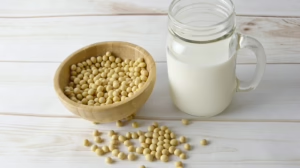Vitamin D Powerhouses: Uncovering the Superfoods for Bone Health
Introduction
Vitamin D plays a pivotal role in maintaining bone health. It facilitates calcium absorption in the gut, which is crucial for bone formation and remodeling. Despite its importance, many people are unaware of the superfoods that can help maintain appropriate levels of vitamin D. This article will delve into the significance of vitamin D, explore various sources—both dietary and non-dietary—and identify the superfoods that can enhance bone health.
Understanding Vitamin D
Vitamin D is a fat-soluble vitamin that comes in two primary forms: D2 (ergocalciferol) and D3 (cholecalciferol). Both forms have different sources and absorption rates, but it is vitamin D3 that is primarily synthesized in the skin through sunlight exposure.
The Importance of Vitamin D for Bone Health
- Calcium Absorption: Vitamin D is essential for the intestines to absorb calcium effectively. Without sufficient vitamin D, bones can become thin, brittle, or misshapen.
- Bone Remodeling: It plays a role in bone remodeling, a process where old bone is replaced by new bone.
- Reduction of Osteoporosis Risk: Adequate vitamin D levels can help lower the risk of osteoporosis, particularly in older adults.
Sources of Vitamin D
-
Sunlight Exposure: The skin synthesizes vitamin D when exposed to sunlight. Approximately 10 to 30 minutes of direct sun exposure several times per week can provide sufficient levels, depending on several factors including skin type, geographic location, and season.
-
Dietary Sources: Vitamin D can also be obtained through certain foods. Fatty fish, beef liver, egg yolks, and fortified products are prime sources.
-
Supplements: For those unable to meet their vitamin D needs through sunlight and diet, supplements can be an effective alternative.
The Superfoods Rich in Vitamin D
In this section, we will explore superfoods that provide substantial vitamin D content while also contributing other essential nutrients for bone health.
1. Fatty Fish
Fatty fish are arguably the richest sources of vitamin D. They are also packed with Omega-3 fatty acids, which have anti-inflammatory properties beneficial for overall health.
- Salmon: A 3.5-ounce (100-gram) serving of cooked salmon provides around 570 IU of vitamin D, making it one of the best sources available. Additionally, it is rich in protein and potassium.
- Mackerel: Costs around 360 IU of vitamin D per 3.5 ounces and contains beneficial fats and nutrients.
- Sardines: These fish provide roughly 272 IU of vitamin D per 3.5 ounces and are often consumed canned, making them an easy addition to various dishes.
2. Cod Liver Oil
Cod liver oil is an excellent supplement and source of vitamin D. A single tablespoon offers approximately 1,360 IU of vitamin D, far exceeding daily recommended intake levels.
In addition to vitamin D, cod liver oil is rich in Omega-3 fatty acids and vitamin A, both critical for health.
3. Fortified Foods
Many foods are fortified with vitamin D to help populations meet their dietary needs.
- Fortified Dairy Products: Milk, yogurt, and some cheeses are often fortified with approximately 100 IU per cup.
- Fortified Plant-Based Milks: Almond milk, soy milk, and oat milk are commonly fortified, offering an excellent alternative for those who are lactose intolerant or vegan.
- Fortified Breakfast Cereals: Many cereals are fortified with significant amounts of vitamin D, often providing up to 100 IU per serving.
4. Egg Yolks
Egg yolks contain about 41 IU of vitamin D per yolk. They also offer high-quality protein and healthy fats, making them a nutrient-dense food choice. However, it’s essential to consume them in moderation due to their cholesterol content.
5. Mushrooms
Mushrooms are unique in that they can synthesize vitamin D when exposed to ultraviolet (UV) light. Certain types provide a solid source, especially when grown in UV light or sunlight.
- Shiitake Mushrooms: Provide a substantial amount of vitamin D2, around 1,000 IU per 100 grams when exposed to UV light. They also add a rich umami flavor to dishes.
- Maitake Mushrooms: Known as hen-of-the-woods, these mushrooms can provide around 786 IU of vitamin D per 100 grams when exposed to sunlight.
6. Beef Liver
While not as popular as other sources, beef liver is an excellent source of various nutrients, including vitamin D. A 3.5-ounce serving provides approximately 50 IU. Its high iron and vitamin A content further enhance its health benefits.
7. Cheese
Certain types of cheese, like Swiss and cheddar, contain small but relevant amounts of vitamin D, usually around 6 IU per ounce. While not a primary source, cheese contributes to overall intake.
The Role of Other Nutrients for Bone Health
While vitamin D is critical, several other nutrients also play essential roles in bone health, including:
1. Calcium
- Importance: Calcium is a fundamental building block of bone tissue. Ensuring adequate calcium intake is crucial for maximizing the benefits of vitamin D.
- Sources: Dairy products, leafy greens, almonds, and fortified foods are good sources.
2. Magnesium
- Importance: Magnesium helps activate vitamin D and plays a key role in converting it into its active form.
- Sources: Nuts, seeds, whole grains, and legumes provide significant magnesium.
3. Vitamin K2
- Importance: This vitamin helps direct calcium to the bones and teeth rather than blood vessels and soft tissues.
- Sources: Fermented foods like natto, hard cheeses, and egg yolks are rich in vitamin K2.
4. Zinc
- Importance: Zinc is vital for the bone mineralization process.
- Sources: Meat, shellfish, legumes, and seeds contribute to zinc intake.
The Synergy Between Vitamin D and Other Nutrients
The interplay between vitamin D and other nutrients creates a synergistic effect. This relationship is vital for ensuring optimal bone health. For example, vitamin D enhances calcium absorption, while magnesium optimizes vitamin D’s action. This interdependence emphasizes the importance of a balanced diet.
Lifestyle Factors Affecting Vitamin D Levels
-
Geographic Location: Individuals living in regions with limited sunlight exposure may have difficulty synthesizing sufficient vitamin D.
-
Seasonal Changes: Vitamin D synthesis peaks in summer months and can significantly decline during winter; dietary and supplement sources may need to be emphasized in winter.
-
Skin Tone: Those with darker skin tones have more melanin, which can reduce the body’s ability to produce vitamin D from sunlight.
-
Age: As people age, their skin’s ability to synthesize vitamin D decreases; older adults are often recommended to increase dietary or supplemental intake.
Conclusion
Vitamin D is integral to bone health, and discovering superfoods that can enhance its levels is essential for maintaining strong bones. Fatty fish, cod liver oil, fortified foods, mushrooms, and various other nutrient-rich foods provide not only vitamin D but also complementary nutrients that contribute to overall wellbeing. Fostering a balanced diet rich in these superfoods, while being mindful of lifestyle factors, will help promote optimal bone health and prevent deficiencies.
Incorporating these factors into daily life can make a significant difference in individual health outcomes, particularly for those at risk of deficiency.
References
- Holick, M. F. (2007). Vitamin D deficiency. New England Journal of Medicine, 357(3), 266-281.
- Bischoff-Ferrari, H. A., et al. (2005). A trial of vitamin D to reduce falls in older adults. New England Journal of Medicine, 357(7), 671-684.
- De Sebastiani, G., et al. (2017). Vitamin D and bone health: An overview. Frontiers in Nutrition, 4, 9.
- Heaney, R. P. (2006). Vitamin D: criteria for safety and adequacy. The Journal of Nutritional Biochemistry, 17(8), 566-574.
- Institute of Medicine (IOM) (2011). Dietary reference intakes for calcium and vitamin D. The National Academies Press.
- Rosen, C. J. (2011). Vitamin D insufficiency. New England Journal of Medicine, 364(3), 248-254.
- Dahlerup, J. F., et al. (2010). Nutritional and lifestyle implications of vitamin D deficiency. Scandinavian Journal of Gastroenterology, 45(7), 788-797.
This comprehensive understanding of vitamin D, its sources, synergistic nutrients, and the superfoods that enhance bone health aims to inform and empower individuals to take charge of their dietary choices and overall health.


























Add Comment